In this tutorial, we will be showing you how to set up a basic Raspberry Pi weather station by utilizing the Sense HAT.
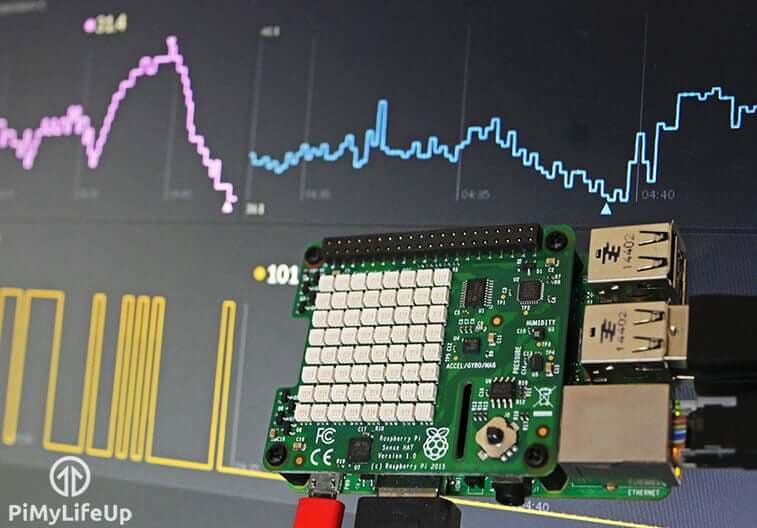
This weather station is the perfect little hobby project for anyone wishing to start monitoring the weather conditions in a specific room, outside or anywhere you would like.
For anyone who doesn’t know, the Sense HAT is a fantastic piece of equipment that comes with a large abundance of sensors all in a single package. It’s the easiest way of adding a ton of sensors to the Pi without needing to do any extra circuitry.
This weather station tutorial will show you how to set up the sense HAT software itself and how to retrieve the data from its three primary sensors, those being the temperature, humidity and pressure sensors. We will also briefly touch on how to write text to the LED Matrix as we will use this as a way of displaying your sensor data.
We will also go into setting up your Raspberry Pi weather station so that the data is stored on Initial States Data analytics service, and this will allow us to stream the data directly to their web interface and view all the data in a pretty graph.
This tutorial will make use of a large amount of Python code, but luckily it’s all pretty basic so you shouldn’t have too many problems following it.
Equipment
You will need a sense HAT and a few other bits of equipment to be able to complete this tutorial.
Recommended
- Raspberry Pi Amazon
- Micro SD Card Amazon
- Power Supply Amazon
- Sense HAT Amazon
- Ethernet Cable Amazon or Wi-Fi Amazon
Optional
- Raspberry Pi Case Amazon
Getting started with the Sense HAT
Before you get started with this tutorial, make sure that you have correctly placed the Sense HAT on the GPIO pins on the Raspberry Pi. It’s an incredibly easy installation and shouldn’t require any extra fiddling once installed correctly.
1. Before we get started, we need to run the following commands to ensure that the Raspberry Pi is running the latest software.
sudo apt update
sudo apt upgrade2. With the Raspberry Pi up to date, we now need to install the Sense Hat software package, and this provides all the libraries we need to interact with the Sense Hat.
sudo apt install sense-hat
sudo reboot3. Now we have the software installed we need to write a quick script to ensure the Sense HAT is working correctly.
We can start writing this script by entering the following nano command.
sudo nano ~/sensehat_test.py4. Write the following lines into this file, and we will explain what each section of code does as we go.
from sense_hat import SenseHatThis line imports the Sense Hat module from the sense_hat library. This library allows us to interact with the Hat itself through python.
sense = SenseHat()This line creates a link to the Sense Hat library and initializes itself so we can start making calls to it.
sense.show_message("Hello World")This line writes a message to the Sense Hat, and you should see “Hello World” scroll across the RGB lights.
Press CTRL + X then Y then press ENTER to save the file.
5. With the file now saved we can run it with the following command:
sudo python ~/sensehat_test.pyThe text “Hello World” should now scroll across the RGB LEDs on top of the Sense HAT. If it doesn’t, it is likely that the HAT has not been properly pressed down on top of the GPIO pins.
If it is still not working, try restarting the Raspberry Pi by rerunning the following command.
sudo rebootSetting up your Sense HAT as a Weather Station
1. Now that we have tested that the Sense HAT is working correctly we can now get writing our Python weather station script. We will start with a basic script that continually reads and displays all the data from the Sense HAT’s sensors.
To begin writing our new Python script run the following command in terminal.
sudo nano ~/weather_script.py2. Now enter the following lines of code into the script, we will explain each block of code as we go.
#!/usr/bin/python
from sense_hat import SenseHat
import time
import sysFirst, we need to import all the libraries that we plan to utilize in our script. In our case, we will be using the following libraries.
sense_hat Library
This import is the library that we utilize to interact with the Sense Hat itself, without this we wouldn’t be able to read any of the sensor data or interact with the LED matrix.
time Library
This import allows us to do a large variety of different time stuff, but for our simple script, we will be just using its sleep functionality. This functionality will enable us to suspend the current thread for a small period.
sys Library
This library provides us access to some variables and functions that are managed by the interpreter itself. In the case of our script, we will be using this to terminate the script if we ever need to do so.
sense = SenseHat()
sense.clear()The first line creates a link to the Sense Hat library and initializes itself so we can start making calls to it.
The second line tells the library to clear the LED Matrix, by default, this means switching off all the LEDs. It’s always a good idea to do this when dealing with the Sense HAT as it ensures nothing is being displayed already.
try:
while True:We set up our first try statement, and we need to do this so we can break out of our while loop by pressing CTRL + C make sure you keep the indentation for the while True.
This required spacing is because Python is sensitive to indentation. The next few lines of code will need a three-tab (12 spaces) indentation.
temp = sense.get_temperature()Getting the temperature is extremely simple, thanks to the Sense HAT Library. All we have to do is make a call to the library for it to retrieve the temperature from the sensor.
The output that this will give us will be in Celsius, it also provides a larger decimal number, but we will deal with that on our next line of code.
We will explain how to convert the temperature to Fahrenheit if you would prefer to deal with that instead of Celsius.
Celsius
temp = round(temp, 1)Fahrenheit
temp = 1.8 * round(temp, 1) + 32 Here we give you two choices for this line of code, and the Celsius code utilizes the value we got from the sensor and rounds it to the nearest decimal place.
The Fahrenheit code is basically the same, the only difference being that we convert the value from Celsius to Fahrenheit.
Celsius
print("Temperature C",temp)Fahrenheit
print("Temperature F",temp)This bit of code is extremely basic and just prints the temperature to the terminal.
humidity = sense.get_humidity()
humidity = round(humidity, 1)
print("Humidity :",humidity)
pressure = sense.get_pressure()
pressure = round(pressure, 1)
print("Pressure:",pressure)Both the humidity and pressure sensors can be read just like the temperature sensor.
Luckily for us, the Sense HAT library makes this incredibly simple. Their values also come back with as a large decimal number, so we will again round them then display the values to the terminal.
There isn’t much extra to say about these two code blocks as they operate just like the temperature code.
time.sleep(1)This line is a simple call to the time library that puts the script to sleep for approximately one second. It is mainly to reduce the rate at which the data is read and outputted.
You can speed up the read rate by decreasing this number or deleting the line. You can also slow it down further by increasing the number. The number should approximately be the number of seconds you want it to wait between reads.
except KeyboardInterrupt:
passThis code makes the try look for a KeyboardInterrupt exception. When it is triggered, we ignore the exception so we can have the script leave the while loop cleanly. We do this by calling pass.
3. With all the code entered into our Python file, you should end up with something that looks like below, of course, this will differ if you have used the Fahrenheit conversion code and not just straight Celsius.
#!/usr/bin/python
from sense_hat import SenseHat
import time
import sys
sense = SenseHat()
sense.clear()
try:
while True:
temp = sense.get_temperature()
temp = round(temp, 1)
print("Temperature C",temp)
humidity = sense.get_humidity()
humidity = round(humidity, 1)
print("Humidity :",humidity)
pressure = sense.get_pressure()
pressure = round(pressure, 1)
print("Pressure:",pressure)
time.sleep(1)
except KeyboardInterrupt:
passOnce your code looks something like the one displayed above, and you are certain you have correctly indented your code you can quit and save, press CTRL + X, then Y and then press ENTER.
4. We can now run our new Python script by running the following command in terminal.
sudo python ~/weather_script.py5. You should now start to see text similar to the following appear in your terminal if everything is working as it should be.
('Temperature C', 30.0)
('Humidity :', 39.8)
('Pressure:', 1025.7)Once you’re happy with the data that is being displayed, you can stop the script by pressing CTRL + C. This will terminate the script from running. Of course, you probably don’t want to have to be looking at your Raspberry Pi’s terminal to be able to get the current data from it.
Instead, we are going to show you two other methods for displaying data, the first of these is to display the data to the LED matrix.
The other method is to utilize a piece of software called Initial State that will allow us to graph the data, and if you decide to pay for the software, you can also store the data over a period of time.
Improving your Weather Station – Utilizing the LED Matrix
1. Changing our weather Python script to start displaying its data to the LED matrix is relatively easy. It will involve us concatenating all our prints together into a single string, then issuing the show_message command to the Sense Hat library.
Before we get started let’s begin editing our weather script by running the following command.
sudo nano ~/weather_script.py2. Now that we are in our weather script we can begin making some changes, above the time.sleep line we need to add an extra line of code. It basically handles everything in one simple line.
Above
time.sleep(1)Add
sense.show_message("Temperature C" + str(temp) + "Humidity:" + str(humidity) + "Pressure:" + str(pressure), scroll_speed=(0.08), back_colour= [0,0,200])Make sure you have typed out this line of code all onto a single line. This change will make the temperature, humidity, and pressure scroll across the Sense HAT LED matrix.
We will explain a bit of what we are doing here. We firstly concatenate the temperature onto the end of “Temperature C”, however since the temp variable is a number we need to wrap it in str() to convert it to a string.
Not converting the string will cause issues due to the way Python interprets adding a number to a string. We do this same process for the humidity and pressure.
We also decrease the scroll speed to 0.08, and we do that with the following part of the code scroll_speed=(0.08) you can increase or decrease this number to either speed up or decrease the speed the text scrolls.
The last bit of code we have on this line is back_colour= [0,0,200], this part of the code sets the background color of the text to blue.
You can also change the color of the text itself. We can do this with our example of setting the colour of the text to a pinky color by adding the following: , text_color=[200,0,200] after back_color[0,0,200].
3. With that line added there is one last thing we will want to add, that being a call to sense.clear().
At the bottom of your script after the exception handling and pass, add the following line of code.
sense.clear()This code will ensure that the LED matrix is completely cleared if we kill the script for any reason. It also stops the annoyance of having to deal with a partially turned on LED matrix and has the added benefit of saving a tiny amount of power, but there is no point on leaving something switched on when you are not utilizing it.
It is also good coding practice to make sure you clean-up everything when you stop a script from running. It helps prevent things like memory leaks from occurring.
4. With those changes made your code should look similar to what is displayed below. Remember that the sense.show_message code should be contained within a single line.
#!/usr/bin/python
from sense_hat import SenseHat
import time
import sys
sense = SenseHat()
sense.clear()
try:
while True:
temp = sense.get_temperature()
temp = round(temp, 1)
print("Temperature C",temp)
humidity = sense.get_humidity()
humidity = round(humidity, 1)
print("Humidity :",humidity)
pressure = sense.get_pressure()
pressure = round(pressure, 1)
print("Pressure:",pressure)
sense.show_message("Temperature C" + str(temp) + "Humidity:" + str(humidity) + "Pressure:" + str(pressure), scroll_speed=(0.08), back_colour= [0,0,200])
time.sleep(1)
except KeyboardInterrupt:
pass
sense.clear()Once your code looks something like the one displayed above and you are certain you have correctly indented your code you can quit and save, press CTRL + X and then press Y and then press ENTER.
5. Now we can test our modified script to make sure that it functions correctly. Run the following command in terminal to run the script.
sudo python ~/weather_script.pyThe text should now begin to scroll across the Sense Hat’s LED matrix. Of course, as you will quickly notice, this isn’t the easiest way of viewing all the sensors data.
The viewability of the display is mainly due to the small nature of the LED matrix making the text more difficult to read and only being able to display a single letter at one time. Of course, if you have an actual LED screen and not a light matrix, it will be a much better option for displaying your data on your Pi.
A nicer way of displaying your data is by utilizing a piece of software such as Initial State. We will go into setting up Initial state and getting our script to send data to it on the next page.
Improving your Raspberry Pi Weather Station with Initial State
1. For those who don’t know, Initial State is a website designed to act as a sort of data storage and data analytics site for the Internet of Things devices like the Raspberry Pi. We’re using Initial state in this tutorial as the Cayenne IOT builder for the Raspberry Pi doesn’t currently support the sense HAT, if they eventually add it, I will update this tutorial to reflect that.
Before we get started with implementing everything for the Raspberry Pi weather station, we will first have to sign up for a free account over at their website.
Once on the site, go to SIGN IN, in the top right-hand corner of the screen.
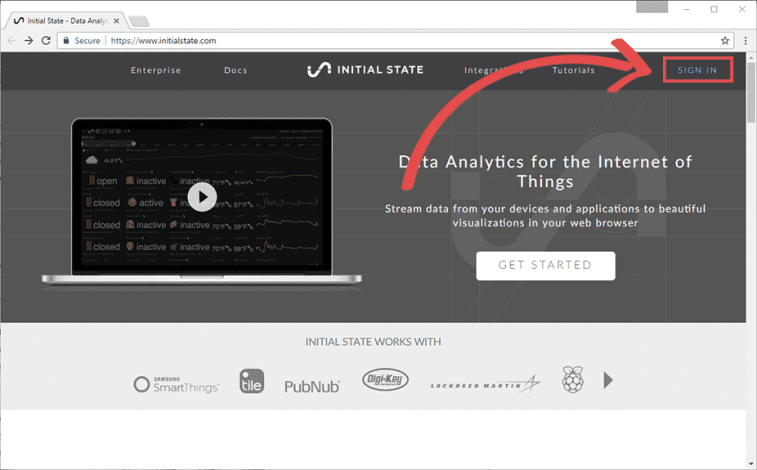
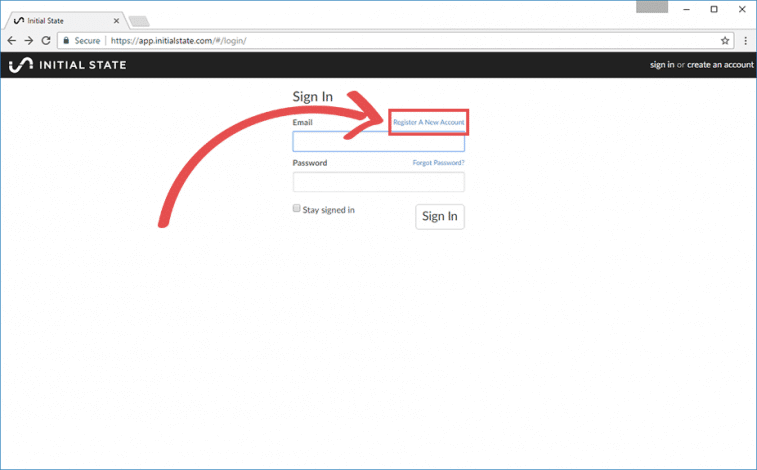
2. Now on the sign in screen, we need click on Register A New Account.
3. Finally, sign up your new user, make sure you set a strong password that you can remember as you will need this to get your API key and view your data.

4. Now with your new user, go back to the sign in page and sign into your new Initial State user, we will need to grab the API key from here before we get started with our script.
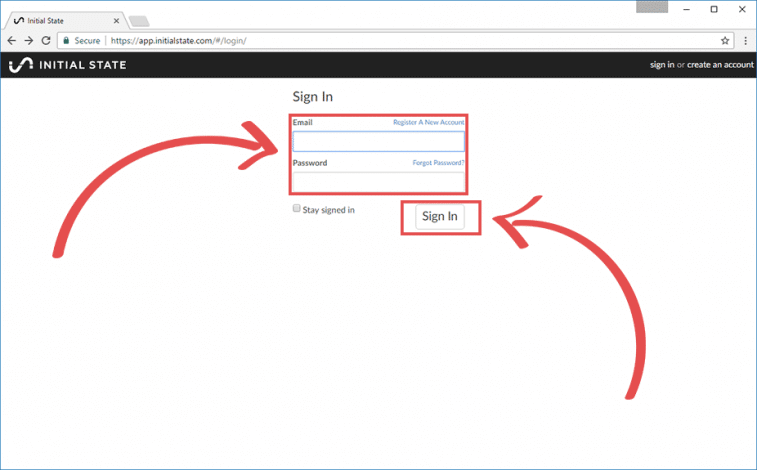
5. You should now be greeted by an empty dashboard screen like below, to get to the screen where you can generate an API key you will need to click on your email address in the top right-hand corner.
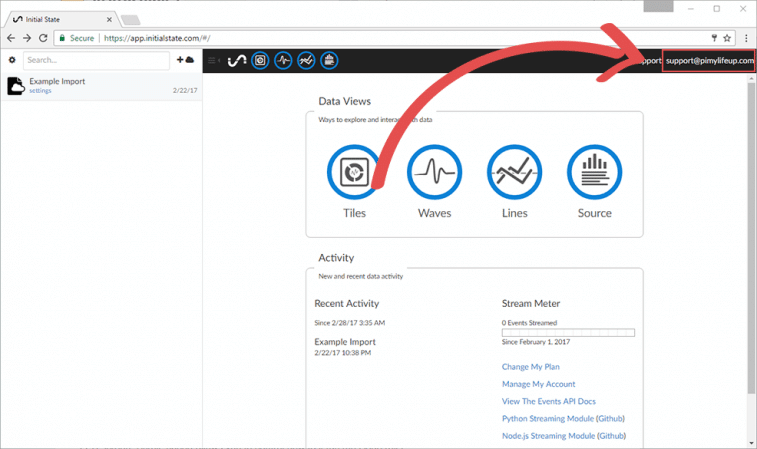
6. Now that we are on our account screen we need to scroll all the way to the bottom and look for Streaming Access Keys, underneath here you should see a Create a New Key button, press it. Once the key is generated write it down somewhere safe, as you will need this for our script.
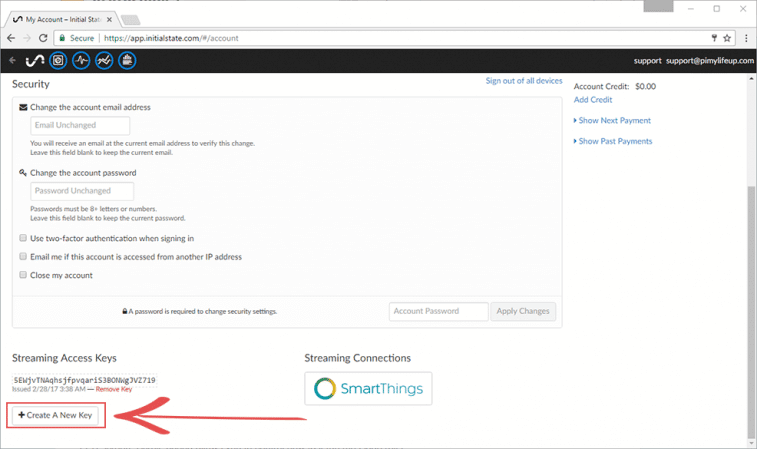
7. We can now get on with installing the Initial State python streamer, to do this we are going to grab their install script directly from their website. While it is not normally safe to run a script through CURL, Initial State is a trusted site. However, if you want to check the script yourself, you can view it by going to the following URL: https://get.initialstate.com/python
If you are okay with running the script, then enter this command into the terminal.
curl -ssl https://get.initialstate.com/python -o - | sudo bash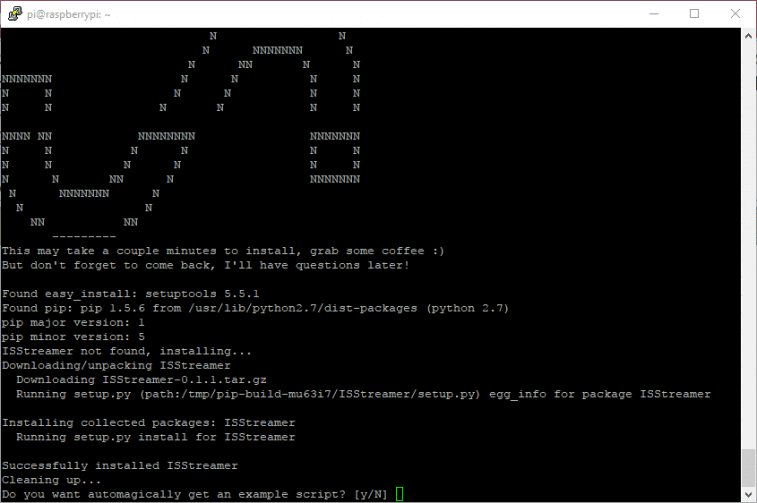
8. Eventually, you will be greeted with the following prompt, press N to skip having to download the example code, and we will not need it for our tutorial.
9. Now we have the streamer installed, and we can begin editing our previous weather script. Run the following command to start editing the file.
sudo nano ~/weather_script.py10. Now we will have first to make a couple of code additions to this file. Add the following lines to the file.
Below
import sysAdd
from ISStreamer.Streamer import StreamerThis line imports the Initial State streamer package, and this will allow us to make a connection to their website and stream our data to it.
Below
sense = SenseHat()Add
logger = Streamer(bucket_name="Sense Hat Sensor Data", access_key="YOUR_KEY_HERE")This line creates the Streamer and initializes a connection with Initial Senses servers, make sure you replace YOUR_KEY_HERE with the key you got in step 6.
Replace
print(With
logger.log(On this step you need to replace all occurrences of print( with logger.log( this will make the script log all your sensor data to Initial State’s website. Luckily for us, the log method of the Streamer object follows the same parameters as print. So, we can just easily swap out the functions.
Your code should now look like something similar to what is displayed below.
#!/usr/bin/python
from sense_hat import SenseHat
import time
import sys
from ISStreamer.Streamer import Streamer
sense = SenseHat()
logger = Streamer(bucket_name="Sense Hat Sensor Data", access_key="YOUR_KEY_HERE")
sense.clear()
try:
while True:
temp = sense.get_temperature()
temp = round(temp, 1)
logger.log("Temperature C",temp)
humidity = sense.get_humidity()
humidity = round(humidity, 1)
logger.log("Humidity :",humidity)
pressure = sense.get_pressure()
pressure = round(pressure, 1)
logger.log("Pressure:",pressure)
time.sleep(1)
except KeyboardInterrupt:
passOnce your code looks something like the one displayed above, and you are certain you have correctly indented your code you can quit and save, press Ctrl+X and then Y and then press enter.
11. Now we have made those changes we can finally run our updated script by running the following command.
sudo python ~/weather_script.pyThe script will immediately start to send your data to the website.
12. Now going back to your Initial State dashboard, you should now see your new data set on the left-hand side, click it.
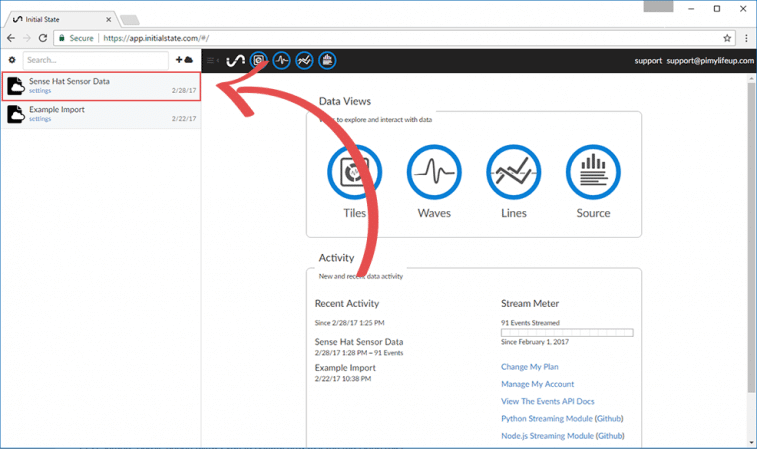
13. With the data set selected, we can now choose how we want to view the data, for this tutorial we will select Tiles as this is the most versatile option.
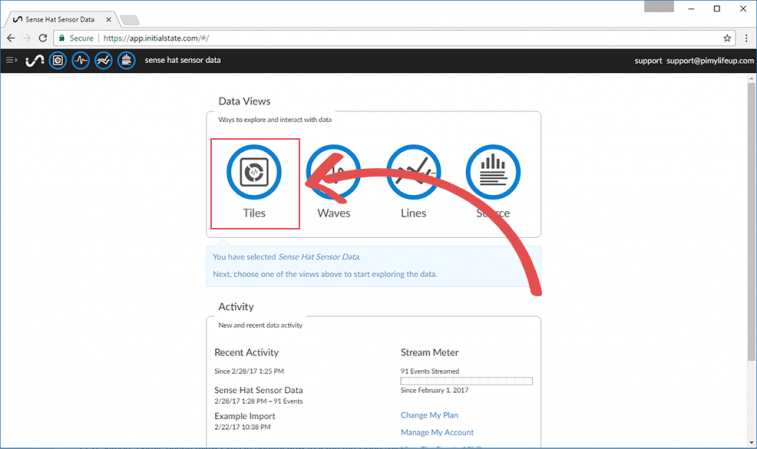
14. You should now be greeted with a display like the one below, and this will continually update itself with the new values as they are sent from your Raspberry Pi.
If you want to change the graph that is being displayed for any of the values, you can right click on them and click on Configure Tile.
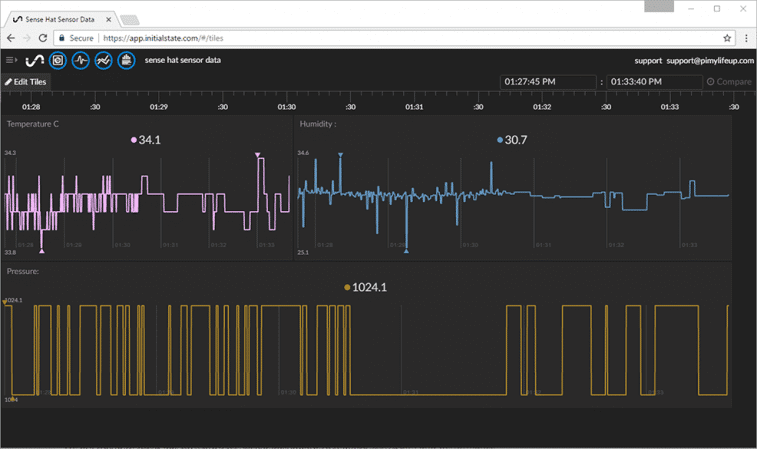
Improving your Weather Station – Start Script at Startup
1. Before we get started with setting up our script, we first need to install an additional package we may have to rely on. This package is dos2unix, and this converts DOS-style line endings into something that is Unix friendly.
Run the following Linux command in the terminal to install the package.
sudo apt-get install dos2unix2. To set up our Python script as a service, so it starts on boot we will need to write up a short script. The advantage of this script is that we will be able to stop it and force a restart easily.
To begin let’s start writing our new script by running the following command.
sudo nano /etc/init.d/weatherstationNow write the following into the file, this is quite a bit of code. You can find all the code we use in this tutorial over at the GitHub page for this tutorial.
#!/bin/bash
### BEGIN INIT INFO
# Provides: weatherstation
# Required-Start:
# Required-Stop:
# Default-Start: 2 3 4 5
# Default-Stop: 0 1 6
# Short-Description: Start/stops the weatherstation
# Description: Start/stops the weatherstation
### END INIT INFO
DIR=/home/pi
DAEMON=$DIR/weather_script.py
DAEMON_NAME=weatherstation
DAEMON_USER=root
PIDFILE=/var/run/$DAEMON_NAME.pid
. /lib/lsb/init-functions
do_start () {
log_daemon_msg "Starting system $DAEMON_NAME daemon"
start-stop-daemon --start --background --pidfile $PIDFILE --make-pidfile --user $DAEMON_USER --chuid $DAEMON_USER --startas $DAEMON
log_end_msg $?
}
do_stop () {
log_daemon_msg "Stopping system $DAEMON_NAME daemon"
start-stop-daemon --stop --pidfile $PIDFILE --retry 10
log_end_msg $?
}
case "$1" in
start|stop)
do_${1}
;;
restart|reload|force-reload)
do_stop
do_start
;;
status)
status_of_proc "$DAEMON_NAME" "$DAEMON" && exit 0 || exit $?
;;
*)
echo "Usage: /etc/init.d/$DAEMON_NAME {start|stop|restart|status}"
exit 1
;;
esac
exit 03. Now we have written all that code into the file, and we can now save and exit it by pressing CTRL + X then pressing Y and then ENTER.
4. Now we have the file saved there is a few things we will need to do to make sure this will correctly work.
First things first we will run dos2unix on our newly created file. This program will ensure the line endings are correct.
sudo dos2unix /etc/init.d/weatherstation5. With that done, we need to now change the permissions for our python script. Otherwise, our init.d bash script will fail to work. Type the following into the terminal to change its permissions.
sudo chmod 755 /home/pi/weather_script.py6. We also need to modify the permissions of our weatherstation bash script, and we need to give it execution rights. We do that by entering the following command.
sudo chmod +x /etc/init.d/weatherstation7. Now finally, we need to create a symbolic link between our bash script and the rc.d folders. We can do that by running the following command in terminal.
sudo update-rc.d weatherstation defaults8. Everything should now be set up, and we can now interact with our new bash file like any other service.
To start up our Python script, we can just run the following command.
sudo service weatherstation start9. Now everything should be correctly set up, and the weatherstation service should now automatically start on boot. We can also stop the script, reload it, and check the status of the script like most services.
Below is a list of commands you can call to interact with the weatherstation service.
This command starts up the service which keeps track of your weather_script.py file.
sudo service weatherstation startThe following command stops the weatherstation service and kills the process that is running our weather_script.py.
sudo service weatherstation stopThis command reloads weatherstation service by killing the process and reloading it.
sudo service weatherstation reloadThe last command shown below retrieves the status of the weatherstation service and our weather_script.py script.
sudo service weatherstation statusI hope that this tutorial has shown you how to set up a basic Raspberry Pi weather station that utilizes the Sense HAT and that you haven’t run into any issues.
It’s certainly a great project for anyone who wishes to set up a cheap weather station. If you have some feedback, tips or have come across any issues that you would like to share, then please don’t hesitate to leave a comment below.










A really good explanation that ended with a good result.
Great tutorial thanks,
Due to the orientation of my Pi the LED matrix was upside down I modified the 1st section of the script to look like this:
I’m not very educated in the field of Raspberry Pi and Sense HAT, so my question is this: Does the Sense HAT register the information of the room it is in or does it (or can it) somehow register the information of the outside?
And is a sense HAT water proof? Logic says no but I still want to ask because if it can somehow register information outdoors then how does it not break in the rain. Me asking this is prob so stupid because I’d have to take my whole computer outside to register readings.
Hi Hannah,
The Sense Hat only monitors the room that it is in. The temperature sensor can also be very inaccurate due to its proximity to the heat of the Raspberry Pi and Sense Hat.
No, unfortunately the Sense Hat is not waterproof and will be damaged/destroyed if it came into contact with rain.
Hello,
Very good tutorial. Thank a lot. But how to display the temperature, humidity etc. on 2 digits ? please, because actually it’s not easy to read.
Have a good day.
Loic
Just edit the Round function parameters.
For example, change the following line, so the found function no longer uses the second parameter.
Your edited line should look like the one below.
Great tutorial, easy to follow!
And, like remarks from others, the temperature is to high indeed.
Must be the CPU heating up.
I suppose there is no simple workaround to measure the room temperature…
Unfortunately, there isn’t a workaround that would make the temperature reading any more accurate.
We do have a weather station project that uses independent sensors on our roadmap but unsure when we will get to it.
I use a 20 line Dupont Cable to get the Sense Hat away from the CPU. Tried Fans and other things to no avail. But getting the Sense hat up and away from RPi board helps tremendously.
File “/home/pi/weather_script.py”, line 17
humidity = sense.get_humidity()
^
IndentationError: unexpected indent
Is that normal? Im looking over the code and it looks perfectly fine…
Hey Xero,
No that is not normal. Sounds like your code is incorrectly indented.
If you would like me to take a look i would recommend copying and pasting it into a service like gist.github.com
Cheers
The “weather_script.py” code snippet has a leading whitespace too much at the sections humidity and pressure. Just remove that and you are fine. Temperature, humidity and pressure must be on the same indentation level.
Remember that python uses indentation to structure the code.
Neat tutorial. However I could not get the service to start. Not sure what I did wrong. Currently I am running this via the command line and it is working.
Great instructions! I’m at the first step, setting up the Sense Hat. Had to fiddle with the temp code due to the known issue of high temps recorded caused by cpu temp, but that was fun. My question is that every 2 or three iterations my temp shows a long string after the decimal. I checked the “rounding code” and it looks right. The funny thing is it’s not EVERY time. Ideas?
Just out of interest… how did you adjust it within the script. I’ve got mine working perfectly but showing 35.6c in a room which is probably about 24.
Would really appreciate some help 🙂
I’m in the US so this is how I fixed the same problem with Fahrenheit. I have a multimeter that reads temp. So I sat it next to the Pi to get an accurate “approximation” of the room temp. In the line of code “temp = 1.8 * round(temp, 1) + 32”, I changed 32 to whatever correction I needed to get an accurate displayed value. In my case +20 worked. I’m sure you can manipulate this line of code to make a correction factor for Celsius. I also abbreviated the message to TpF, Hu, Pr. If the sample rate is 1 sec, the sense hat is actually sampling faster than the message is displaying. Which is ok I guess.
One thing I hope someone can clarify for me, is the pressure reading in millibars? If so, has anyone changed this to inHg?
Very easy and cool project!
Nice write up. Easy to follow and a frustration free success. Thanks for your time writing this up.